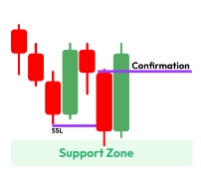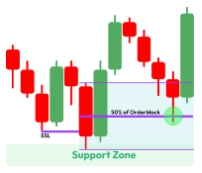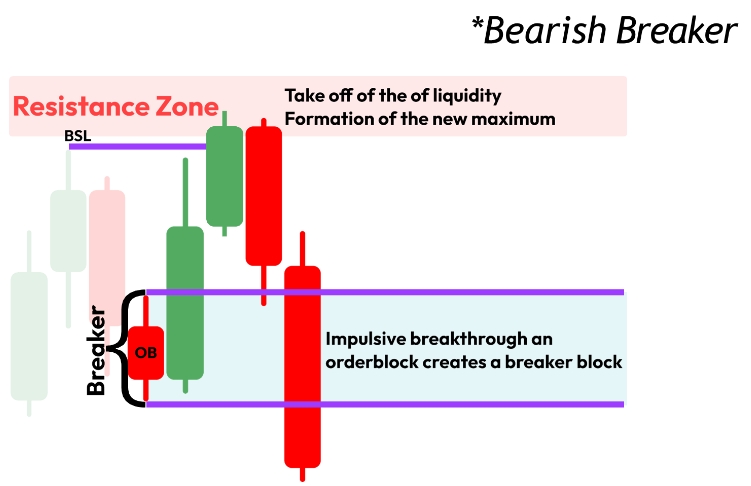The Orderblock
Orderblocks (OB) are specific candlesticks that, when viewed correctly in an institutional context, can highlight the buying or selling of a major player.
Such candlesticks act as a support or resistance zones. This happens because a large trader has shifted the price to one side by buying or selling in search of liquidity. This way a lossmaking position was opened, and in order to close it, we expect a return to the orderblock and a move in the opposite direction.
Bullish orderblock
The lowest candlestick that takes off the liquidity (SSL candle), which is in the support zone.

Engulfing of the lowest candle confirms the orderblock and leaves an imbalance after the engulfed candle.

The first zone where you can expect a reaction will be the maximum of the orderblock.
Often the shadows are ignored, because the main volume of orders was traded in the body of the candlestick.

The second reaction zone is 50% of the orderblock body (use the Fibonacci grid to determine the 0.5 level).

To determine which orderblock is most likely to give a reaction, choose an OB below which there are no FVG and no significant liquidity pools.
Bearish orderblock
The highest rising candle that takes off liquidity (BSL), which is in the resistance zone.

Engulfing of the highest candle confirms the orderblock and leaves an imbalance after the engulfed candle.

The first zone where you can expect a reaction will be the minimum of the orderblock body. Often the shadows are ignored, because the main volume of orders was traded in the body of the candle.

The second reaction zone is 50% of the orderblock body (use the Fibonacci grid to determine the
0.5 candle)

To determine which orderblock is most likely to react, choose an OB above which there is no FVG and no significant liquidity pools.
Stop Loss
Stop-loss is placed above the shadow of the orderblock - maximum candles. After the test and the formation of a new LL stop loss can be moved above 50% of the candle to reduce risk.
Use an orderblock along with the shadows to be more likely to open a position. The price can fill the imbalance and turn in the opposite direction without testing the body of the candle, which acts as an orderblock
The main criteria for the formation of an orderblock:
Engulfing of a candle that takes off the liquidity;
Imbalance after engulfing;
Breakdown of the structure (an additional factor);
Formation of a orderblock at the support zone/resistance.
The Breaker
The breaker can be used as a reversal or trend continuation model. Represents a impulsive move breakthrough orderblock after formation of a new structural element (HH/LL).
Bullish Breaker
Before a bullish breaker is formed, the price takes off the liquidity (SSL) from the previous structural element:
From HL to continue the uptrend;
From LL when the structure changes to an uptrend.
After which the movement begins in the opposite direction. The breaker is confirmed by an impulse breakthrough the orderblock.

The highest rising candle of the impulsively broken orderblock will act as a bullish breaker - a new support zone. When the price returns to the that area, it will be a bullish set-up, which can be considered for finding an entry point into the position.
The breaker is defined with the shadows of the pierced orderblock.
Before an impulse breakout, the price can test or trade in a bearish (OB) without going over its upper boundary: this will not affect the relevance of a future breakout.


For more efficient operation, use 50%/full fill FVG in combination with a breaker.
Stop Loss
The stop loss can be placed under the breaker - this is considered as an aggressive stop, which has a high probability of being taken out, but allows you to open positions with a high ratio of risk/profit.
You can also put a stop below the low that takes off the liquidity. This is considered a conservative stop that is safe. And, most likely, price will not activate it if your analysis is correct.
The Breaker
The breaker can be used as a reversal or trend continuation model. Represents a impulsive move breakthrough orderblock after formation of a new structural element (HH/LL).
Bearish Breaker
Before a bearish breaker is formed, the price removes liquidity (BSL) from the previous structural element:
From (LH) for the continuation of the downtrend;
From (HH) when the structure changes to a downtrend.
After which the movement begins in the opposite direction. The breaker is confirmed by an impulse breakthrough the orderblock.

The lowest falling candle of the impulsively broken orderblock will act as a bearish breaker - a new resistance zone.
When the price returns to the that area, it will be a bearish set-up, which can be considered for finding an entry point into the position.
The breaker is defined with the shadows of the pierced orderblock.
Before an impulse breakout, the price can test or trade in a bullish (OB) without going over its lower boundary: this will not affect the relevance of a future breakout.

For more efficient operation, use 50%/full fill FVG in combination with a breaker.

Stop Loss
The stop loss can be placed over the breaker - this is considered as an aggressive stop, which has a high probability of being taken out, but allows you to open positions with a high ratio of risk/profit.
You can also put a stop abowe the high that takes off the liquidity. This is considered a conservative stop that is safe. And, most likely, price will not activate it if your analysis is correct.
The main criteria for the formation of the breaker block:
Taking off the liquidity from the maximum/minimum;
Impulsive breakthrough an orderblock;
Formation of a breaker block after the test of support/resistance zone.